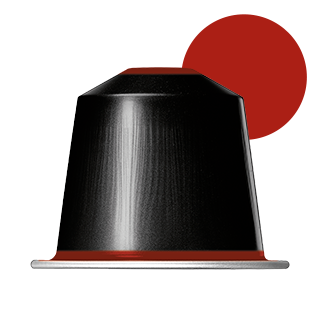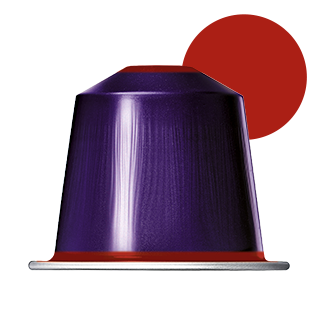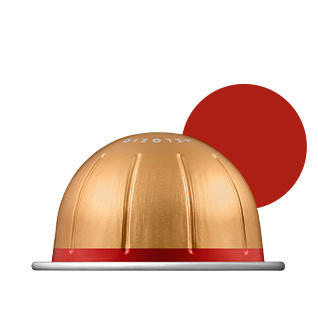Header
Enjoy our Original coffees without caffeine

Original
Volluto Decaffeinato
Discover Volluto Decaffeinato
Sweet & Light
Discover Volluto Decaffeinato, a balanced blend of Arabicas from Brazil and Colombia with a delightful aroma, a dense body, and notes of biscuit.
Discover Ristretto Decaffeinato
Powerful and contrasting
Enjoy Ristretto Decaffeinato, a blend of dark roast with subtle fruity accents. A charming nod to the iconic culture of Italian coffee.

Original
Ristretto Decaffeinato

Original
Arpeggio Decaffeinato
Discover Arpeggio Decaffeinato
Intense et Onctueux
Let yourself be charmed by Ispirazione Firenze Arpeggio Decaffeinato, an elegant coffee with a hint of cocoa, wrapped in a velvety texture.
Discover Vienna Lungo Decaffeinato
Round and smooth
Remarkably round and creamy. You cannot miss the warm notes of malted cereals that develop in this blend.

Original
Vienna Lungo Decaffeinato
Our decaffeinated coffees Original
Enjoy our Vertuo coffees without caffeine

Vertuo
Melozio Decaffeinato
Discover Melozio Decaffeinato
Smooth and balanced
Relax with a cup of Melozio Decaffeinato in hand, a coffee with unmatched smoothness, classic cereal notes, and a round honey flavor.
Discover Fortado Decaffeinato
Intense and full-bodied
Experience a bold coffee moment with Fortado Decaffeinato, a characteristic blend of Indian robusta and Colombian arabica. The aromatic notes of cocoa and oak enhance the sumptuous flavor palette of this sensation.

Vertuo
Fortado Decaffeinato

Vertuo
Altissio Decaffeinato
Discover Altissio Decaffeinato
Full-bodied and creamy
Let yourself be enchanted by Altissio Decaffeinato. This intense coffee combines Arabica from Costa Rica and Robusta from Brazil. A powerfully roasted blend, rich in contrasts, with a creamy texture and subtle cereal notes.
Discover Sweet Vanilla Decaffeinato
Vanilla & Creamy
Discover notes of caramel and vanilla, which will offer you a velvety and delicate coffee break. This coffee made from 100% Arabica beans features biscuity aromas for a gourmet decaffeinated beverage.

VERTUO
Sweet Vanilla Decaffeinato

Vertuo
Double Espresso Chiaro Decaffeinato
Discover Double Espresso Chiaro Decaffeinato
Intense and balanced
Enjoy this intense double espresso that will be a perfect finishing note for your meal. Its woody and roasted cereal notes will delight your taste buds..
Our decaffeinated coffees Vertuo
6 Revelations About the Mysteries of Decaffeinated Coffee
-
GOODBYE CAFFEINE
Do you have a tendency towards nervousness? Coffee can still increase that tension, as a cup of coffee contains between 1 and 2.5% caffeine. Reducing your caffeine intake and drinking decaffeinated coffee more often can therefore be beneficial. Especially when you know that our Decaffeinato coffees contain the same antioxidants and nutrients as their caffeinated counterparts. Don’t thank us. -
A DELIGHT BEFORE BEDTIME
Caffeine-free coffee? It’s the pleasure of enjoying your favorite hot beverage without limits, even late at night. While caffeinated coffee often prevents you from falling asleep, a cup of Decaffeinato allows you to sleep soundly. Zzzzzzzzzzzz, sweet dreams. -
FAMOUS LOOKALIKES
Do the Decaffeinato capsules seem familiar to you? It’s no coincidence. We have developed decaffeinated versions of Nespresso's most iconic coffees. You will recognize them by their red ring. There’s no need for a meticulous tasting. Just choose your favorite coffee with or... without caffeine. -
FROM ORIGINAL TO VERTUO
Original or Vertuo? No matter how you enjoy Nespresso, the Decaffeinato assortment includes 3 Original coffees and 3 Vertuo coffees with a range of flavors, aromas, and intensities. Treat yourself ! -
100% NATURAL
How is our decaffeinated coffee made? Nespresso deliberately opts for natural methods, without the use of chemical solvents. We remove caffeine from the coffee beans using hot water or liquid carbon dioxide. This way, the delicious properties of your coffee are optimally preserved. Furthermore, and this is important, this process is 100% safe for your health. -
FOR TRUE COFFEE LOVERS
Not for true coffee lovers, decaffeinated coffee? On the contrary! The blends of our Decaffeinato coffees are made from the same coffee beans as their caffeinated counterparts. The only difference is the caffeine content. They are and remain a full-fledged variety of coffee.
How is our decaffeinated coffee made ?
There are different decaffeination processes. The chemical decaffeination method is one of the most common methods. It involves the use of chemical solvents to extract caffeine from the coffee bean. Once the extraction is done, the solvents are removed from the coffee bean using hot water and steam. Although effective, this method can leave solvent residues on the coffee bean, which can affect the taste and quality of the coffee.

What manufacturing methods does Nespresso use ?
While some manufacturers use this technique, Nespresso has chosen not to opt for chemical solvent decaffeination for its decaffeinated coffee capsules. Instead, Nespresso uses only natural ingredients to preserve the properties of the coffee. Two methods are generally employed :
Decaffeination with water
This technique involves moistening the beans to give them a porous texture. They are passed through water to remove caffeine and other elements. In the next step, the extracted material is dissociated and filtered through activated charcoal, allowing for the separation of the caffeine contained in the beans from other soluble particles. The latter are reintroduced into the beans, which are then dried and traditionally roasted.
Decaffeination with carbon dioxide
During this alternative process, the beans are also moistened before being placed in a tank. This tank is pressurized using liquid carbon dioxide, which passes through the coffee beans and naturally extracts all the caffeine. The beans are then dried and roasted.
These two technical methods of decaffeination chosen by Nespresso have a major advantage: they preserve the properties of the coffees, thus maintaining all the strength, variety, and richness of their aromas.
Another benefit: these techniques are free from artificial solvents and therefore have no impact on the environment. Perfectly suited for special tasting moments.
Nespresso's decaffeinated coffee is Fairtrade coffee, produced with respect for the beans of the world's finest coffees, without any additives: this is the secret to its rich and intense flavor.
A minimum of caffeine
For decaffeinated coffees, this represents between 2 and 3 mg of caffeine per cup. An infinitesimal amount compared to that of regular coffees. For example, other ranges from Nespresso contain between 50 and 85 mg of caffeine per cup. Despite the minimal presence of caffeine, decaf is thus the perfect alternative to traditional coffee for those who wish to limit their caffeine intake or who have difficulty tolerating it.

Decaf, a coffee with preserved taste
Another idea circulates about decaffeinated coffee: its taste and quality would be different from that of regular coffee. This is completely false !
At Nespresso, it is defined by other characteristics, such as the origin of the coffee, the blend, the body, and the bitterness. It is primarily the roasting process that determines the intensity and flavor of the coffee. This process develops the numerous (sometimes more than 900) aromas of the beans as well as the taste molecules. It is the combination of these two elements that creates the final flavor of the espresso, much to the delight of aficionados of this beverage!
Of the same quality as traditional coffee, Nespresso's decaffeinated options are therefore perfect counterparts to caffeinated coffees, whether in Original coffee capsules or Vertuo coffee capsules. Their flavors, aromas, and intensity are preserved so they can be enjoyed during the day or in the evening

A decaf coffee at the same price as a regular coffee !
In general, decaffeinated coffee is slightly more expensive than its caffeinated alternative. This is due to the decaffeination process, which requires special equipment and techniques to remove caffeine. At Nespresso, this additional cost is kept as low as possible in the final price of caffeine-free products so as not to prevent you from enjoying your favorite beverage.
Ultimately, the choice between decaffeinated capsules and regular capsules should be based on your personal preferences and health needs, rather than on price.
